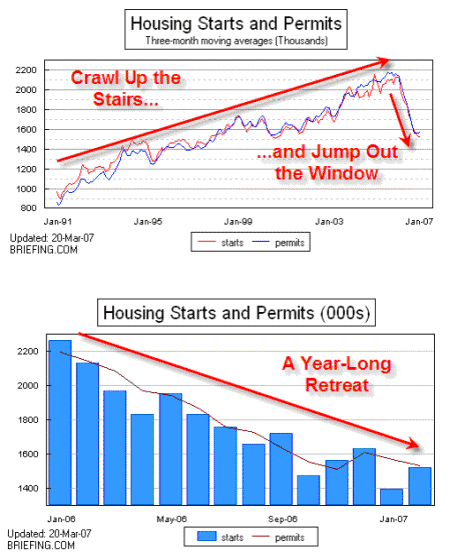
This time last week, the market just capped off a solid day, following news that February housing starts climbed 9%.
On the face of it, that’s all well and good. But for me, the data wasn’t a cause for celebration.
While 9% was a solid rise, the improvement was calculated from figures in January – numbers that were 9-year lows! After taking a massive swoon, a reverse move upward is expected.
This got me thinking about the housing market in general. And having ploughed through the data and charts, it seems to me that this is a ‘house of cards’ (pun intended) that could get much worse before it gets better.
So let’s look at some key indicators out there and devise a plan for dealing with this huge economic driver…
The real estate house party is over
If you take a look at the charts below, first showing the figures for housing starts and permits from January 1991 to January 2007, then a closer look at the numbers for the past year, you can clearly see the current trend.
When you take the broader perspective into account, it’s tough to interpret the small rise in February housing starts. Additionally housing permits fell again in February – an issue that was overshadowed by the better-than-expected housing starts number. And the data on sales of new homes in February that came out yesterday was less encouraging.
Beware biased reporting on real estate
There’s no question that commercial and residential real estate makes up a huge part of the U.S. economy. But because so many people are now feeding at the real estate trough, it’s tough to find unbiased comments about the market – especially when almost everyone has a vested interest in a continually rising real estate market.
Just about every word on the housing market that is printed or spoken in the media is put through that biased filter. That means even the smallest victory is celebrated when it may not actually be good news for the real estate market.
There are some new wrinkles in the real estate market that make the housing bubble ‘different this time.’ While we (and other countries) have witnessed normal housing boom and bust cycles over the years, there are two huge mitigating factors that accompany this one:
1. Not Learning From 1929: Failing to take a lesson from the 1929 stock market crash, regulators have allowed lenders to extend unprecedented leverage to real estate buyers. We have seen what may be only the tip of the iceberg with the problems in the sub-prime lending market.
2. Public Company Pressure: Because there are a large number of homebuilders listed on the stock market, these companies have keep chalking up consistently good results – both for the good of the market, as well as their shareholders. And when they can’t (like now), their shares get crushed. In the past two weeks alone, Lennar was the second company to put up earnings that were way down – some 70-80%, and to cap it off, then guide lower for the rest of the year. Result? Lennar dropped from a close of $45.58 last Friday to an intraday low of $42.64 today, before closing at $44.50.
Expect more real estate weakness
New Home Starts Up + New Home Sales Down = Investor Beware
As the numbers showed, new home starts in February rose solidly – albeit from very low levels.
But new home sales declined by 4% – below the consensus estimate of almost all analysts. This is the news that had the stock market reeling on Monday – and is another warning sign.
But here’s an even more disturbing sign in the new home sales: There were big downward revisions for the last three months of data. This shows that the market may be even weaker than first imagined.
So given this data, what’s a prudent investor to do?
I strongly suggest that you not try to catch a falling knife in the housing market. Just last weekend in Denver, I spoke about investing principles at a predominantly real estate conference… and I heard one horror story after another from both brokers and investors.
No matter how good the bargain looks, it’s always wise to look for solid proof on the price charts that the market has really turned from down to up before jumping in.
By D.R. Barton, Jr., Quantitative Analyst,